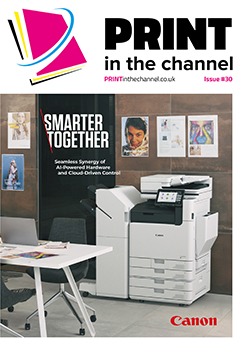Sustainability has risen up the corporate agenda in recent years, with all aspects of a business charged with reducing their environmental impact. Print is part of this, although often strategies have involved reducing paper consumption, but there is much more than can be done to improve sustainability and resellers have a crucial role helping businesses to achieve this.
The recent COP28 summit of world leaders in Dubai put environmental issues front and centre in world news once again, as a historic agreement was struck to commit to move away from the use of fossil fuels in the future.
But while global leaders were talking about what nations can do to cut their environmental impact and ensure global temperature increase is limited to 1.5°C above pre-industrial levels – currently, the Earth is already about 1.1°C warmer than it was in the late 1800s, and emissions continue to rise – there is much that businesses can do on a smaller scale.
Add into this the UN’s 2030 targets for trying to achieve net zero carbon emissions, and there is plenty that can be done, including the print industry – manufacturers and resellers – as well as end users now and in the future to become more sustainable.
Significant role
“As we edge nearer to the UN 2030 targets for greenhouse gas emissions, sustainability is likely to be a primary focus for many businesses across the board,” says Arjan Paulussen, managing director, Western Europe & English Speaking Africa at Lexmark.
“Here, print manufacturers can play a significant role in reaching sustainability targets, not only by reducing energy consumption and paper waste but also through the entire print supply chain, including manufacturing and procurement processes.”
Arjan adds that to ensure true print sustainability, devices need to be designed with sustainability at front of mind. “Intentionally engineering devices to last longer and maintain quality of function over many years, not only ensures less waste to landfill but also provides the value businesses are looking for from their office hardware investments,” he says.
Peter Dresser, product marketing manager: ECOSYS at Kyocera agrees that sustainability is increasingly important for businesses, especially when it comes to the print fleet. “All end users are interested in underpinning their own green agendas and look to their suppliers to do the same,” he says. “Kyocera understands this, as a company that is serious about its corporate social responsibilities, we work hard to keep the cost and environmental impact of printing to a minimum. As such, Kyocera’s devices incorporate long life components, recycled plastics and market leading initiatives such as carbon neutral devices.”
Recycle and remanufacture
Arjan adds that one way to increase the sustainability of printers is for more recycling and remanufacturing of products in the market. “While many in the print industry have already adopted recycling programmes and incorporated the use of post-consumer recycled materials (PCR) into manufacturing processes, hardware remanufacturing and refurbishment initiatives are still not as widespread,” he says.
“However, there is great potential for remanufactured products, not only for the reduced cost to the environment but also for the reduced cost to the business, as remanufactured products can be sold at a lower price point. Although, manufacturing a device that can last in the field for an extended duration should be the always be the preferred option.
“In 2022 alone, 36% of Lexmark toner cartridges worldwide were returned through the Lexmark Cartridge Collection Programme to be remanufactured into new ones, demonstrating the strong demand for effective and user-friendly sustainability initiatives such as remanufacturing programmes.
“The Lexmark Equipment Collection Programme goes even further ensuring Lexmark devices maintain the same quality as a new device with up to 90% reused or repaired parts and a significantly reduced carbon footprint.
“Businesses want to be sustainable but need cost-effective, manageable solutions that do not put added strain on operations. Here, print vendors and resellers that work in partnership with businesses and support them in their sustainability efforts will enable real environmental change.”
Changing demands
As sustainability becomes more important, customer demands are changing to reflect this, Peter adds. “End users have always demanded quality, reliability and longevity from their print devices, a requirement that Kyocera is well placed to fulfil,” he says. “Customers are now asking about the energy efficiency of their printers and MFPs, which is not an issue for Kyocera as we have always designed our products to be energy efficient as possible with most devices using as little as 0.5w of power in sleep mode.
“As for consumables, if users purchase original toners, they can offset their environmental impact through our carbon neutral initiative.”
Peter adds that resellers should be talking to their customers about sustainability and environmental impact. “For instance, Kyocera is a carbon neutral company, so our devices incorporate long life components, recycling is built-in and we operate a comprehensive range of carbon neutral initiatives,” he says.
There is also more emphasis on print devices lasting longer, Peter adds. “Customers are discovering more and more the environmental benefits,” he says.
This shows how manufacturers in the print sector are helping customers to move towards their sustainability goals and, with it, contribute to helping nations towards their overall targets. While some improvements in sustainability may be small it all helps – and the more businesses that make small improvements, the bigger the overall effect and, hopefully, the more the effects of climate change will be mitigated.










